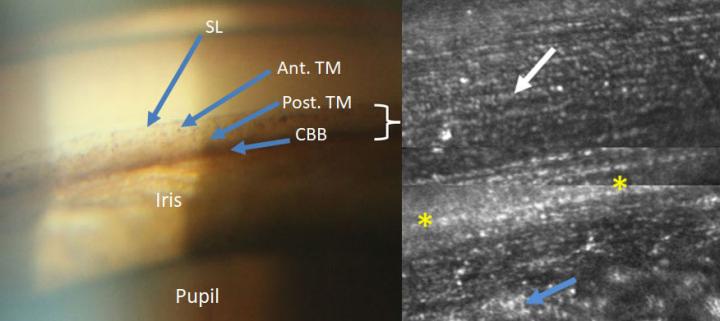Indiana University optometry researchers took the first undistorted images of the eye’s trabecular meshwork using methods originally developed to stop stars from appearing to twinkle

Credit: Image courtesy the Indiana University School of Optometry.
BLOOMINGTON, Ind. — Using methods originally developed by astronomers to view stars more clearly through Earth’s atmosphere, optometry researchers at Indiana University have taken the first undistorted microscopic images of a part of the eye involved in glaucoma.
The ability to clearly view this structure — known as the trabecular meshwork — could help improve treatment for glaucoma. The work is reported in the journal of Translational Vision Science and Technology.
“Normally, clear fluid circulates inside the eye to supply nutrition and keep it ‘inflated’ to its normal shape,” said Dr. Brett King, chief of advanced ocular care services and associate clinical professor at the IU School of Optometry, who co-authored the study. “Alterations of the trabecular meshwork, which allows fluid to drain, elevates pressure in the eye, leading to glaucoma. The problem is the meshwork can only be seen poorly with the normal instruments in your doctor’s office, due to its location where the iris inserts into the wall of the eye, as well as the near-total reflection that occurs when looking through the cornea.”
The result of this low visibility is a lack of understanding about why age appears to cause the trabecular meshwork to function poorly. It also makes it difficult to study why certain glaucoma treatments that target the trabecular meshwork — such as laser therapies or invasive surgical procedures — fail while others succeed.
More effective treatments for glaucoma are needed since the number of people with the condition worldwide is expected to rise from 76 million in 2020 to over 111 million in 2040, disproportionally affecting people in Asia and Africa. In the U.S., it’s estimated that over 3 million people currently have glaucoma, costing the economy over $1.5 billion annually.
To view the trabecular meshwork, IU researchers modified an existing ophthalmic laser microscope with a programmable mirror able to deform in real time to correct for the eye’s imperfections. The technology, called “adaptive optics,” is accurate within ten-millionths of a millimeter, which is precise enough to visualize single cells or measure blood flow inside the retina.
Designed by astronomers to correct for the same atmospheric distortions that make stars appear to twinkle, adaptive optics uses a real or artificial point of light — whether an illuminated spot on the retina or a “guide star” in astronomy — to rapidly compute distortion rate and then correct for it.
According to study co-author Stephen Burns, the technology is similar to “a very expensive and very versatile funhouse mirror.” An IU faculty member who was not involved in this study, Donald Miller, was among the first imaging scientists to adapt the technology to imaging the eye’s retina in the late 1990s. Burns has been working on the subject since the early 2000s.
The new study extends the method to a part of the eye beyond the retina. In the paper, IU researchers report that the use of adaptive optics successfully imaged the trabecular meshwork in nine study participants, including two with pigment dispersion syndrome, an eye disorder that can lead to a form of glaucoma.
“Thanks to this research, the ocular drainage area of the eye can now be seen with much-improved clarity, which will improve our understanding of how this essential drainage area is being altered or damaged with age,” King said. “We’re very hopeful that this technology may help improve understanding and management of glaucoma, since many members of our team are clinicians who’ve managed patients with this disease for years.”
###
Additional authors on the study are Dr. Thomas J. Gast, a senior scientist at the IU School of Optometry, and Ting Luo and Dr. Kaitlyn A. Sapoznik, both Ph.D. students in optometry. The work was funded in part by the National Institutes of Health’s National Eye Institute and an Allergan Foundation Research Grant from the American Academy of Optometry.
IU Research
Indiana University’s world-class researchers have driven innovation and creative initiatives that matter for nearly 200 years. From curing testicular cancer to collaborating with NASA to search for life on Mars, IU has earned its reputation as a world-class research institution. Supported by $680 million last year from our partners, IU researchers are building collaborations and uncovering new solutions that improve lives in Indiana and around the globe.
Media Contact
Kevin D. Fryling
[email protected]
812-856-2988
Related Journal Article
http://dx.




